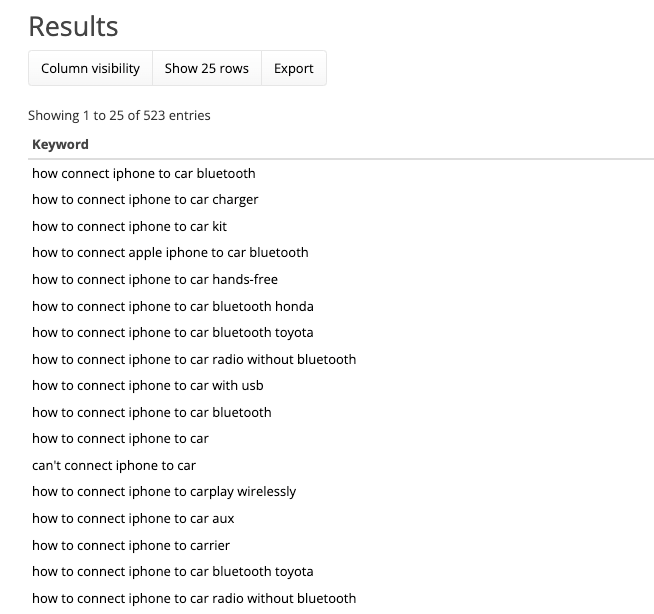Table of Contents
Of all the different SEO strategies out there, targeting long tail keywords is probably one of my favorite ones. By their nature, long tail keywords have lower search volumes. While this means lower demand, the good news is that there is generally less competition and a higher conversion intent. Finding long tail keywords is a great way to find opportunities to create new content and connect with users who have a very specific goal in mind.
Related Content:
However, the challenge with long tail keywords is that they might not be immediately obvious. Upon doing some initial keyword research, you may find that the bulk of the terms you uncover are higher volume and higher competition “head” queries. In order to find these wonderful long tail keywords, you may need to dive a little deeper.
How To Find Long Tail Keywords:
Here’s how to find long tail keywords:
- Integrate Search Console with Data Studio
- Review Google Ads data
- Look at high performing forums
- Scrape Google Autocomplete
- Utilize internal search data
Below, we’ll go more in depth in each one of these methods.
1. Use Data Studio To Find Long Tail Keywords
My favorite methodology of finding long tail keywords is by using Google Data Studio. This strategy works great if you have a larger site but haven’t been able to access all of your query data in Search Console. One of the biggest frustrations of many SEOs is that Search Console limits you to 1,000 queries in their export.
However, a little known fact is that you can actually get a much larger export from Search Console by using Data Studio instead. Larger datasets mean you’ll have more opportunities to mine for long tail queries.
Here’s how to create a Data Studio report that provides more of your Search Console queries:
- Open up Google Data Studio
- Click on Create > Report
- In Connect to data search for “Search Console”.
- Find your site and choose “Site Impression” & “web”
- Remove “Google Property” from “Dimension”
- Click “Add Dimension” and select “Query”
- Add any additional “Metrics” that you like (Impressions, Site CTR, Average Position)
Now you should have access to a much larger number of queries from Search Console. Here you can see that I have access to 150,000+ queries in this report.
This process allows me to go much deeper into finding long tail keywords in my research. Armed with this data, I can mine individual topics to find low competition terms.
For instance, let’s say that I wanted to create more content around iPhones and identify some easy to compete for keywords. I could create a simple filter that shows me “iphone” queries above 100 impressions.
Next I could sort in ascending order to find low competition queries that have few impressions. One keyword I found was “retrieve deleted text messages iphone without backup”
When reviewing the SERP for this keyword I can find that the competition isn’t overwhelming and there are no branded results from apple.com present. This might make a good opportunity to create new content for a very specific issue that users are having.
2. Review Google Ads Data For Long Tail Keywords
I’ve said many times that PPC data is extremely underutilized by SEOs. It’s one of the only places where you can still find conversion/revenue data at the keyword-level. By ignoring these insights, SEOs are missing out on opportunities to better understand what queries are driving qualified traffic and where there are gaps in the SEO strategy.
Many PPC campaigns bid on a large variety of keywords. Combine this with Google’s changes to the broad match modifier and it’s a recipe for finding a lot of long tail queries within your PPC data.
Currently, in Universal Analytics, the “Search Queries” report makes these terms very easy to find by using filters to drill down to lower volume queries. How you do this will depend on how much traffic you generate from Google Ads but here’s a general process that I use:
Universal Analytics
- Navigate to Google Analytics
- Go to Acquisition > Google Ads > Search Queries
- Click “advanced”
- In this example I filtered by queries between 20-200 sessions with more than $500 in revenue
If you’re using GA4, the following process should help you identify these keywords with Google Ads data.
Google Analytics 4
- Navigate to Google Analytics
- Go to Acquisition > Overview
- Find the card with your Google Ads campaigns and select “View Google Ads campaigns”
- Select the “Session Google Ads campaign” dropdown and select “Session Google Ads query”
From there you can identify longer tail terms associated with revenue-generating queries from Google Ads. This is an extremely powerful way to find low competition keywords that have conversion potential.
3. Review High Performing Forums
Another strong way to find low competition terms is by analyzing forum sites. Forums provide a great resource for users to ask questions and get answers for very specific problems that they have. Since many users often have the same problem, these forum questions are often mapped to long tail queries and can end up ranking in the SERPs. However, these forum results can generally be easily surpassed by a well-written and optimized article.
For example, if you’re in the home improvement space, you might see forum questions from doityourself.com ranking well from time to time. This is a community where users can ask questions about common issues they’re having with their DIY projects.
To find long tail keywords at scale, we can run this forum through a tool like Ahrefs to find instances where a forum thread might be ranking well. We might also want to drill down to specific topics that we know we want to focus our content around.
In this example, I found opportunities where the forum is ranking well around “garage” keywords by following these steps:
- Open up Ahrefs
- In the search bar, add the URL prefix in (https://www.doityourself.com/forum/). Ensure “Path” is selected.
- Select the “Organic keywords” report in the left sidebar
- Perform a search
- In the “Keyword” dropdown, select “contains” and then your target topic (“garage” in this example”).
Here we can see a list of queries where a forum page is ranking well.
We can then review the SERPs for these queries to verify there’s weaker competition for these long tail phrases. Here you can see that there are two forum threads ranking in the top three results. This means there’s a prime opportunity for new content to be created as an article may be easily able to outperform these forum threads.
If you know of a forum in your industry that you’ve seen appear on the first page, it’s typically a good idea to analyze what queries that forum ranks for. You can leverage that knowledge to create your content for those same topics. While the forums vary by industry, broader ones to target would be sites like Reddit and Quora.
4. Scrape Google Autocomplete For Long Tail Keywords
Google Autocomplete is probably one of the fastest ways to quickly generate content ideas that are mapped to long tail keywords. This is because autocomplete tries to make query suggestions based on what previous users have looked for. As a result, you can quickly get a lot of suggestions around very specific topics.
Going back to the iPhone example, when I enter “how to connect iphone to tv”, you start to see that Google suggests some pretty specific queries. I could start reviewing these topic ideas and see if any would be a good fit for our content strategy.
Of course, the most powerful way of doing this research is to utilize some type of tool that scrapes Google Autocomplete. This is an extremely fast way of getting a lot of query suggestions that could make great long tail keywords to target.
When using Google Autocomplete, a great strategy can be thinking of the core topic that you want to find long tail keywords for and then using question modifiers before the topic. Some of the most common question modifiers include:
- How
- Why
- Can
- What
- When
- Does
There are a variety of tools out there that scrape Google Autocomplete but I recommend using one called Keyword Sh!tter. It uses a really simple interface and is extremely straightforward to use.
Here I just entered three seed keywords to scrape Google Autocomplete:
- how to connect iphone to tv
- how to connect iphone to car
- how to connect iphone to ipad
Within a minute I already have 500+ different queries that it found from Google’s Autocomplete.
You can then export the data and run it through your search volume tool of choice. Here, I simply took the terms and ran it through Google’s Keyword Planner. You can then use “Avg monthly searches” as a gauge to determine what types of queries you think would make great long tail keyword opportunities.
5. Find Long-Tail Keywords In Internal Site Search Data
If your site generates a large amount of traffic from internal search, this is another good place to check for long tail keywords. This strategy generally works the best if you’re an eCommerce site and you’re looking to identify specific category pages that are mapped to low competition keywords. If users are commonly using this feature, you might be sitting on a lot of data that’s work checking out.
You can use the following process to find this data in Google Analytics:
Universal Analytics
- Navigate to Google Analytics
- In the left sidebar go to Behavior > Site Search > Search Terms
- Click “advanced”
- Create your filtering criteria. Here I looked for search terms that generated at least $1,000 in revenue with fewer than 200 unique searches
This will show you a report of internal queries that aren’t searched that frequently but still contribute to a considerable amount of revenue. Of course, the individual criteria that you use will be determined by how frequently people utilize and convert off your site’s internal search functionality.
While internal search data can be useful for identifying longer tail keywords, there are some drawbacks to this method. Generally, users don’t get too specific when using internal search. A user is much more likely to look for “skinny jeans” than “size 10 black skinny jeans” using internal search. Most eCommerce sites will have a faceted navigation that will allow the user drill further down into the product attributes that they’re looking for. However, if you’re looking for longer tail keywords, internal search data shouldn’t be ignored!
With all of this information in mind, you should be well equipped to start finding long tail keyword opportunities for your site. By utilizing these methods, you should be able to identify lower competition queries that better connect with some of your most prominent users.
Search News Straight To Your Inbox
*Required
Join thousands of marketers to get the best search news in under 5 minutes. Get resources, tips and more with The Splash newsletter:











